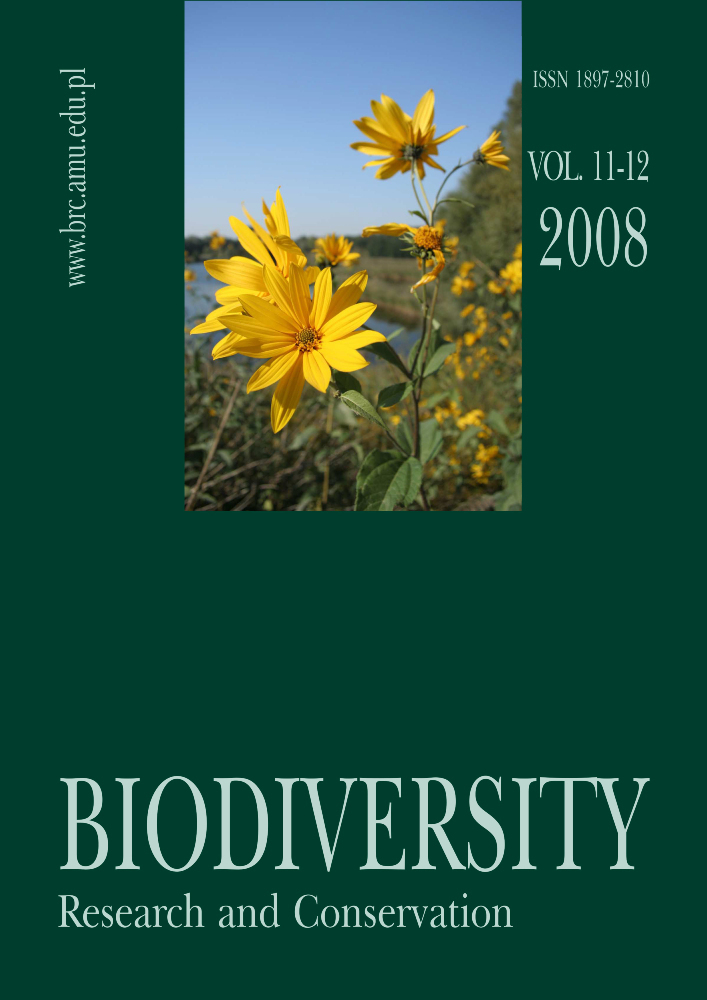Abstract
The aim of the studies conducted in 2004-2008 was to estimate and compare the diversity of synanthropic flora of the kurgans and their microhabitats in three steppe zones in southern Ukraine. Kurgans located among large fields and pastures are very characteristic element of the Ukrainian landscape. Among the 400 visited kurgans, 81 were investigated within an area of about 20 000 km2 in the desert steppe, Pontic grass steppe and herb-grass steppe zones. The total number of species (613), as well as percentage of synanthropic species (55%) was estimated. The number of species on the kurgans in each zone increased along a south-north gradient. However, the percentage of groups of synanthropic species on the kurgans was comparable. Differences between microhabitats (within kurgans) with regard to the proportion of synanthropes were smaller in the case of the desert steppe zone. Contrasts between the microhabitats were more significant in the case of the steppe zones further to the north. The flora of kurgans is determined by the climate conditions of a particular zone and by the form of utilization of the area.
Funding
The study was supported by the Ministry of Science and Higher Education in Poland in 2004-2007 - the Research Project No. 2 P04G 046 27 and in 2008-2009 - the Research Project No. NN 304 081835.
References
ANDRIENKO T. L. (ed.). 1999. Zapovidni kutochki Kirovogradskoi zemli. 240 pp. Arktur, Kyiv.
ARTEMENKO I. I., BARAN V. D., BIBIKOV S. M., DOBZHENOK V. J., LESKOV O. M., TELEGIN D. JA. & TERENOZHKIN O. I. (eds.). 1975-1985. Archeologija Ukrainskoj SSSR. Vol. 2, 3. 500+502 pp. Naukova Dumka Press, Kyiv.
BARCZI A. 2003. Data for the botanical and pedological surveys of the Hungarian kurgans (Great Hungarian Plain, Hortobagy). Thaiszia, J. Bot. 13: 113-126.
BARCZI A. & JOÓ K. 2000. Kurgans: Historical and ecological heritage of the Hungarian Plane. Elöadás. International Conference on Multifunctional Landscapes. Roskilde, Dánia, 2000. október 18-21. Conference Material, p. 199-200.
BILYK G. I., OSYCHNYUK V. V., TKACHENKO V. S., GRYN F. O. & KOSETS M. I. 1973. Roslynnist URSR. Stepy, Kam’yanysti vidslonennya, pisky. 428 pp. Naukova Dumka, Kyiv.
BOHN U., GOLLUB G., HETTWER C., NEUHÄUSLOVÁ Z., RAUS T., SCHLÜTER H. & WEBER H. (eds.). 2000. Karte der natürlichen Vegetation Europas, Maßstab 1:2 500 000. Bundesamt für Naturschutz, Bonn.
CWENER A. 2004. Rośliny naczyniowe kurhanów w dorzeczu dolnej Szreniawy i Nidzicy (Wyżyna Małopolska, południowa Polska). Fragm. Flor. Geobot. Polonica 11: 27-40.
CWENER A. 2005. Różnorodność flory roślin naczyniowych kurhanów w dorzeczu Szreniawy i Nidzicy (Wyżyna Małopolska, południowa Polska). In: K. WASYLIKOWA, M. LITYŃSKA-ZAJĄC & A. BIENIEK (eds.). Roślinne ślady człowieka. Botanical Guidebooks 28: 297-304.
CWENER A. & TOWPASZ K. 2003. Kurhany jako ostoje różnorodności gatunkowej w rolniczym krajobrazie Płaskowyżu Proszowickiego. Chrońmy Przyr. Ojcz. 59(6): 57-65.
KONDRATYUK E. N. & CHUPRINA T. T. 1992. Kovylnye stepi Donbassa. 172 pp. Naukova Dumka, Kyiv.
KORNAŚ J. 1981. Oddziaływanie człowieka na florę: mechanizmy i konsekwencje. Wiad. Bot. 25: 165-182.
KUBCZAK J. 1978. Kurhany arystokracji scytyjskiej. Wyd. Uniwersytetu A. Mickiewicza w Poznaniu, Ser. Historia Sztuki 9: 7-167.
LAVRENKO E. M., KARAMYSHEVA Z. V. & NIKULINA R. I. 1991. Stepi Eurazji, pp. 5-143. Izdat. Nauka, Leningrad.
LOGVINOV K. T. & SHCHERBAN M. G. (eds.). 1984. Priroda Ukrainskoi SSR. Klimat. 232 pp. Naukova Dumka, Kyiv.
MARYNYCH A. M., PASHCHENKO V. M., SHISHCHENKO P. G. 1985. Priroda Ukrainskoi SSR. Landshafty i fizikogeograficheskoe raionirovanie. 224 pp. Naukova Dumka, Kyiv.
MELNIK V. I. 2001. Luchni stepi lisostepu Ukraini. Botanikogeografichnyi narys. Visti Biosfernogo Zapovidnika Askania Nova 3: 7-14.
MOSYAKIN S. L. & FEDORONCHUK M. M. 1999. Vascular plants of Ukraine: A nomenclatural checklist. xxiv + 346 pp. M. G. Kholodny Institute of Botany, National Academy of Sciences of Ukraine, Kiev.
MOYSIYENKO I. I. & SUDNIK-WÓJCIKOWSKA B. 2006a. The flora of kurgans in the steppe zone of southern Ukraine - phytogeographical and ecological aspects. Polish Bot. Studies 22: 387-398.
MOYSIYENKO I. I. & SUDNIK-WÓJCIKOWSKA B. 2006b. The flora of kurgans in the desert steppe zone of southern Ukraine. Chornomorski Bot. Journ. 2(1): 5-35. DOI: https://doi.org/10.14255/2308-9628/06.21/1
PACZOSKI J. K. 1914. Khersonskaya flora: Kherson. Vol. 1, 514 pp. Kherson.
PACZOSKI J. 1933. Szata roślinna kurhanu króla Władysława Warneńczyka. PTPN, Prace Komisji Mat.-Przyr., Ser. B, 6: 157-172.
SMIRNOV A. 1974. Scytowie. 217 pp. PIW,Warszawa.
SUDNIK-WÓJCIKOWSKA B. & MOYSIYENKO I. I. 2006. The flora of kurgans in the west Pontic grass steppe zone of southern Ukraine. Chornomorski Bot. Journ. 2(2): 14-44. DOI: https://doi.org/10.14255/2308-9628/06.22/2
VERNANDER M. B. & TYUTYUNNIK D. A. (eds.). 1986. Priroda Ukrainskoi SSR. Pochvy, 214 pp. Naukova Dumka, Kyiv.
YANATA A. A. 1913. Flora stepi Melitopolskogo i jugozapadnoi chasti Dnieprovskogo uezdov Tavricheskoi gubernii. 250 pp. Tipografia Tavricheskogo gubernskogo zemstva. Simferopol.
License
Copyright © by Adam Mickiewicz University, Poznań, Poland, Department of Plant Taxonomy, 2008OPEN ACCESS




